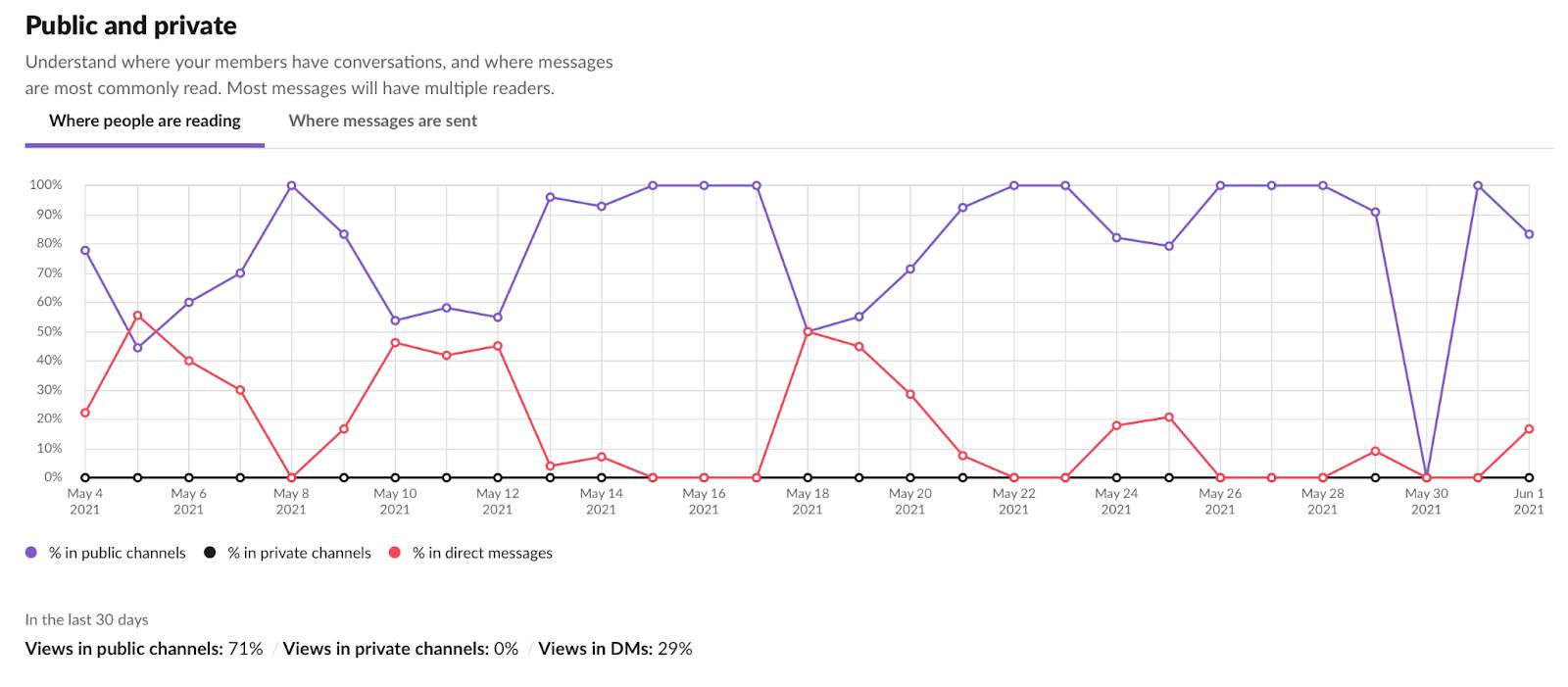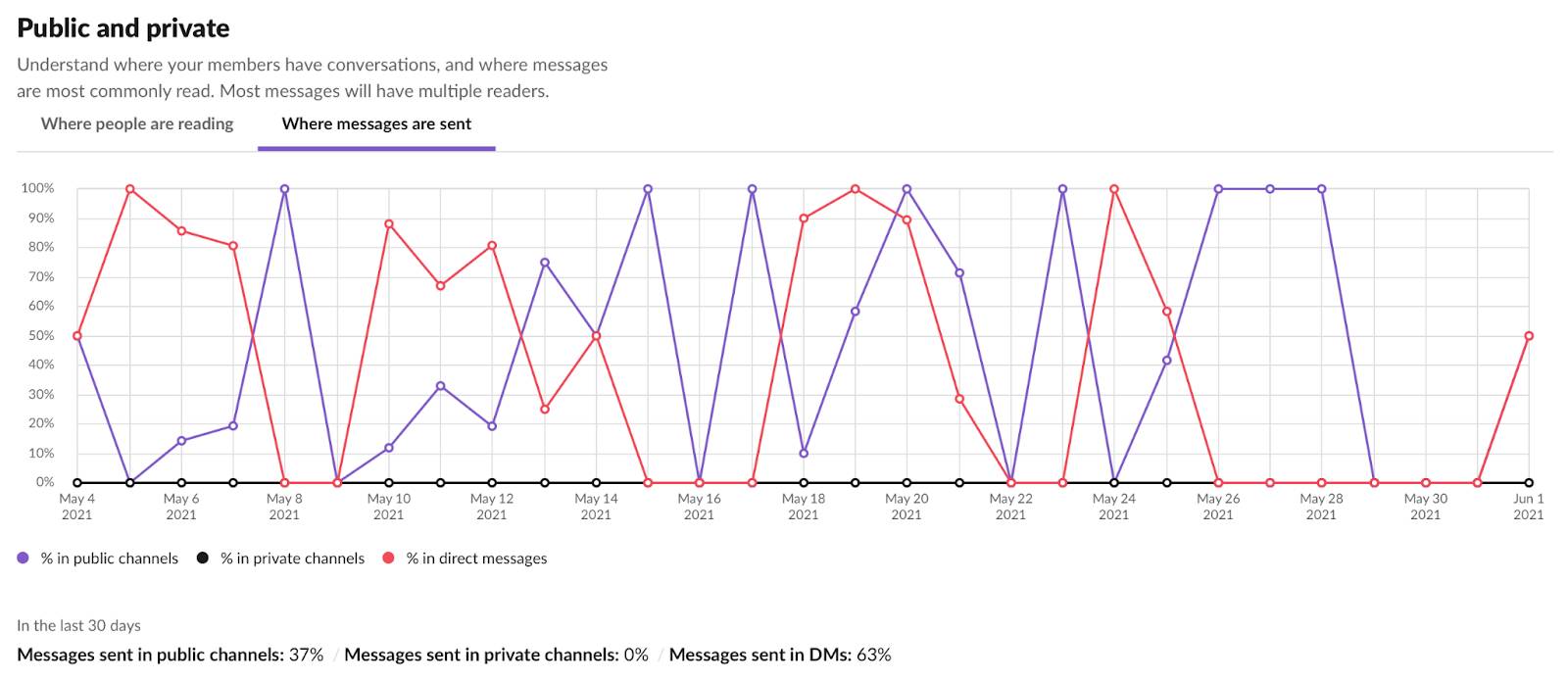Measure Adoption and Engagement
Learning Objectives
After completing this unit, you’ll be able to:
- Use member analytics to track adoption.
- Use member analytics to track user engagement.
Measuring Adoption
Digital adoption sounds easy, but you probably already know there's much more to successful adoption than meets the eye. It doesn’t matter how great a tool seems in theory—if users don’t know why or how to use it, they won’t make it a part of their working lives.
Digital adoption results in individuals successfully:
- Listing the potential benefits of the tool
- Using the tool to achieve specific goals
- Using the tool to do work and optimize processes
You can use Slack analytics to track and measure whether employees are gaining true value from Slack. Analytics also give you insight into themes and trends in adoption, so you can solve for the unique needs of your organization.
Adoption metrics help you measure breadth of use. Are employees actively using Slack and making the most of your investment?
Let’s review five common metrics for adoption that you can find in your Workspace Analytics dashboard.
Measuring Engagement
Adoption measures the breadth of the value Slack brings to your organization, while engagement measures the depth.
Engagement can mean slightly different things to individual organizations, but understanding what engagement means in your workspace helps you tell a deeper story about how your members use Slack to get work done.
Use Slack analytics to understand and measure:
-
Where conversation is happening.
-
How information flows in your organization.
Slack analytics help you uncover key trends, problem areas, and success stories. In this section, we focus on key metrics that can help you measure engagement. An important measure of engagement is where members spend their time in Slack. Are they interacting in channels, or communicating mostly through direct messages?
Direct Messages vs Channels
Slack communication happens in two places: direct messages and channels. Direct messages involve between two and nine participants and are similar to a one-on-one meeting or a hallway conversation between colleagues. The participants don’t need input or visibility from others to get work done. Direct messages are great for one-off questions, informal conversations, and topics that are only relevant to a handful of people. Channels are more similar to an interest group meeting, project planning committee, or large group conversation over lunch. Channels are generally focused on a certain theme (for example, quarterly planning or mountain biking) and include information that is valuable to a broader audience.
Using Slack’s Analytics dashboard, you can access data that tells you exactly where your members spend most of their time. The data is broken down by where people are reading messages, as well as where they’re sending messages. You can find this breakdown in the Public and Private section of the Overview tab.


Perhaps your members are sending a lot of direct messages. This can be a sign of healthy relationships within and among your teams. However, if most of your organization’s time is spent sending and reading direct messages, this is a sign that most work is being done via direct message rather than channel. While some work is moved forward by smaller, direct conversations, this isn’t always the case. And sometimes, siloing information in direct messages can undermine the very goals your organization is trying to achieve by moving to Slack (for example, transparency and collaboration).
Take a moment to check in on your own analytics page. Where are most conversations happening? Do you prefer your members to work in channels or direct messages?
When you understand where your members spend their time, and what it could mean for your organization, you’re better equipped to recommend the Slack behaviors that best reflect your organization’s goals.
Want to Learn More?
If you’re ready to take your analytics skills to the next level, check out the Trailhead Academy site. That course is a deep dive for Slack administrators on managing permissions and using a combination of Slack’s native-built features (such as message activity analytics) and APIs to set goals and measure success. Many of the features covered are only available to admins on the Business+ and Enterprise Grid plans.
Get Slack Certified
Whether you’re building Slack experiences at your company, consulting on Slack implementations, or developing Slack apps, more careers than ever are built on Slack.
The Trailhead Academy program helps you build the knowledge, skills, and mindsets to be successful in:
- Tailoring Slack’s features and settings for your organization
- Building apps and experiences on Slack’s Platform
- Guiding your organization to use Slack more productively
Once you’re certified, you can show off your credentials to the broader community of professionals building on Slack.
Resources
- Slack Help Center: What is a direct message?
- Slack Help Center: What is a channel?
- Trailhead Academy: Salesforce Certified Slack Administrator
- Trailhead Academy: Salesforce Certified Slack Consultant
- Trailhead Academy: Salesforce Certified Slack Developer